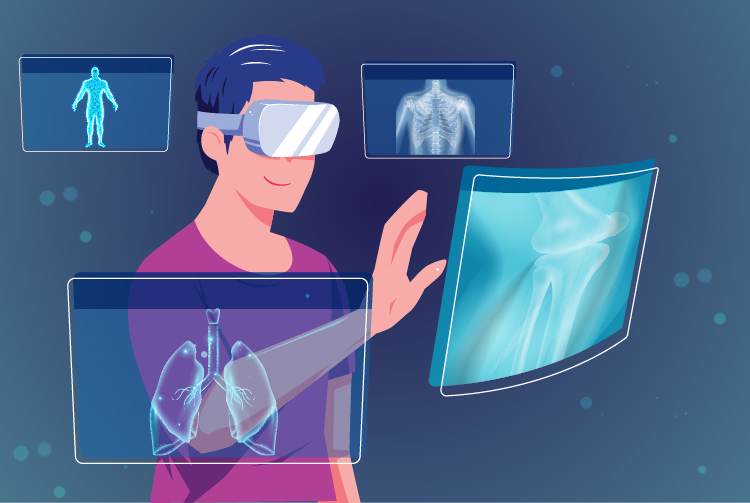Immersive Virtual Reality for Surgical Training:
Virtual Reality is bringing a new wave of innovation to the healthcare sector. VR Surgical Training is more impactful than cadaver lab training. It improves decision-making, creates a safe environment for practice and mistakes, and ultimately promotes a high level of engagement in the training process. According to the Goldman Sachs Global Investment Research, 82% of healthcare professionals agree that virtual reality creates a convenient way to access and learn information for medical students and practicing healthcare professionals.
Virtual Reality in Surgical Training:
VR surgery is a medical surgery performed on a three-dimensional virtual model of a patient using VR technology. These virtual procedures allow medical students to acquire skills and knowledge without putting real patients at risk and receive clear feedback on their actions. Virtual training allows future doctors to develop confidence and gain the necessary experience.
Through virtual reality training, medical students can immerse themselves in the surgical experience long before they enter a surgical residency. They can observe surgeries and even see operations from a first-person perspective. Virtual reality puts students ahead of the curve in the first place.
The ability to perform surgery on a 3D model instead of an actual patient also helps them learn a new medical technique or improve previously learned skills.
![]() For Surgeons
For Surgeons
Surgeons can experience being in a real operating room while having the ability to clearly see the environment through a VR headset and even interact with it using manual controls.
These controls simulate real medical instruments and allow students to operate on the patient virtually, which improves the accuracy of their movements.
For Students
The VR surgical simulator comes with a unique pod that allows the students to interact with the computer-generated three-dimensional model through tactile instruments.
These devices provide the practitioner with visual, tactile, force, and acoustic feedback on their every movement. They feature high pixel density graphics that give students a realistic idea of the process in real-time. It helps in reducing stress while practicing.
How VR makes surgery training better
VR technology brings many benefits to the healthcare and surgical industry.
A recent study has shown that using virtual reality for surgical training can reduce both operation time and error rates, as well as increase accuracy, compared with traditional endoscopic training. In addition, VR technology offers new possibilities in surgical training that are not doable with the standard text-based and video training materials.
Benefits
An in-depth view of human anatomy
Virtual reality brings deeper interaction with human anatomy in a whole new way. Virtual reality provides a better understanding of the human body in a virtual environment and makes the training process close to the real process.
Broadcasting operations
Virtual reality also offers improved methods of medical training by allowing the broadcasting of surgeries performed by experienced professionals.
Remote assistance
Using Virtual reality in medicine and surgery, medical professionals can get real-time help from their colleagues anywhere in the world. Remote assistance allows surgeons to share complex trauma and injury cases in real-time for an immediate consultation.
Improving patient experience
VR technology also helps patients understand what they can expect from surgery by visualizing their condition, the operations required to address it, and the expected outcome.
Final Thoughts
With Virtual reality, healthcare organizations have taken great strides in the field of surgery. VR technology takes medical training to a new level and significantly improves the quality of medical services.
And with the virtualization trend on the rise, there’s a clear opportunity for them to benefit from cutting-edge VR-enabled medical software. So it won’t take long for the use of Virtual Reality in surgeries to become a common occurrence.


 For Surgeons
For Surgeons
